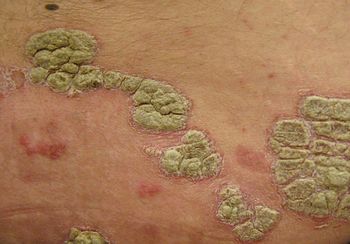 |
| Psoriasis (Photo credit: Wikipedia) |
WebMD defines psoriasis as a “baffling and persistent skin disorder.” With no real cure and treatment methods that have side effects, psoriasis can be a daunting condition to handle. Although, it is not a life threatening condition, it does reduce the quality of life and according to WHO estimates, affects more than 140 million people on the planet. Drugs, currently, in the market are primarily aimed at suppressing the immune system in general. So, although, symptoms reduce, the body is not putting up its best defense and the patient is prone to secondary infections. However, a promising study published in Science Translational Medicine might just enable us to treat psoriasis and not just symptomatically. But to understand this, we first need to look into what really happens in psoriasis.
Psoriasis involves the abnormal production of skin cells due to a cascade of inflammatory responses which are triggered by Tumor Necrosis Factor (TNF) and Interleukin-22 (IL-22). These cytokines (cellular chemical signals) are responsible for the inflammation (redness of the skin) seen in early stages of the condition and sets the tone for disease progression. Greater the trigger greater would be the cellular response and thus, severe the condition in the patient. Treatments of psoriasis with topical ointments or medications usually begins at an elevated level of inflammation, which basically means that the treatment is lagging far behind the cause of the condition. It is no surprise then that psoriasis cannot be cured and is only treated symptomatically.
 |
| Role of cytokines in development of psoriasis. TNF and IL-22, the major contributors are marked in RED.
|
 |
| AND Gate |
The cure for psoriasis may still be far away but research findings such as these are harbingers of hope for many other inflammatory diseases as well. In the future, treatments could include injecting gene circuits that can do much more than detect one or two markers alone and this is good news for patients of cancer too.
If you would like to read more of these interesting stories from the world of science, subscribe to our blog and we will send you an email every time we post something new and interesting. Alternatively, you can follow us on social media such as Facebook, Twitter or Google Plus!
Reference:
Schukur L, Geering B, Charpin-El Hamri G, & Fussenegger M (2015). Implantable synthetic cytokine converter cells with AND-gate logic treat experimental psoriasis. Science translational medicine, 7 (318) PMID: 26676608

